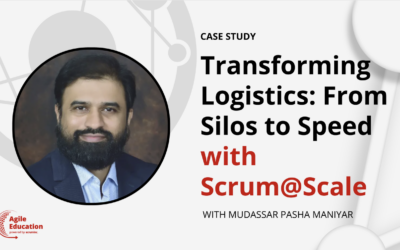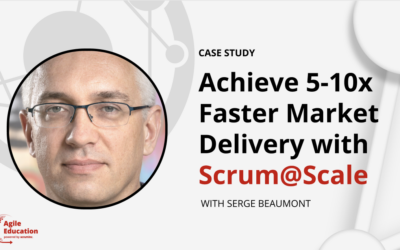Scrum@Scale Case Study
Entirely New Solutions to Entirely New Challenges with Gabe Jank
In this Scrum@Scale case study, learn how Registered Scrum@Scale Trainer Gabe Jank led a Fortune 500 manufacturer of farm, construction and forestry machinery to react quickly and effectively to the myriad of new challenges presented to the industry during the global pandemic.
CASE STUDY SNAPSHOT
Organization: Anonymous
Industry: Agriculture, Forestry, Fishing and Hunting & Manufacturing
Topics: Minimal Viable Product (MVP), Prioritization
Organization Size: Large
Date: 2019-2020
Website: Gabe’s LinkedIn
Scrum@Scale Case Study Summary: Connecting People
Gabe was faced with the challenge of guiding a machinery manufacturing company’s Brazilian branch through the challenge of losing direct and personal access to their customers due to the pandemic. While very successful, the company had a waterfall structure that left it unequipped to adapt rapidly to an entirely new business model. Previously, 80% of their sales happened in person at agriculture or construction fairs. In addition, service and support were provided in person. To add to the challenge, their market is a seasonally driven enterprise, with a small market window prior to the season in which the equipment is needed during which purchasing happens. When all the fairs were canceled in 2019, new solutions to connect with customers were immediately needed.
The Solution: Decisions with the Minimal Viable Product
The team was composed entirely of volunteers. In the ideation stage, there was no direct leadership or management, but the team was empowered to make decisions. The idea was to really think outside the box because nothing they knew or solutions they had would cover the new challenges being faced. The original estimate for a platform that would allow for 3-D visualization of the equipment, a way for customers to purchase replacement parts, and allow dealers to have direct charts with customers was five months. However, due to the seasonal sales market window they had to find a way to sell and support their product in a seven-week time frame. Velocity and value with a minimal viable product were the key elements.
Volunteer teams were formed with minimal bureaucracy. An Executive Action Team (EAT) was formed to remove impediments, consisting of Gabe as the coach, two directors, a coach and Chief Product Owner (CPO). The EAT was connected to three cross-functional, multi-disciplinary teams with marketing, pricing and dealer support, with three partners responsible for IT.
The three pillars of the team were: deliver the platform, build the content, release the platform for marketing. The first week was spent on training, and then they jumped right into solutions.
With the seven-week total seasonal window they decided to prioritize farming product line, Portuguese language content, and focus on the online platform, not apps. They restricted the scope for a minimal viable product.
- This prioritization allowed them, in seven short weeks, to complete 70% of the value and 30% of the features
- During the following three months, they completed the remaining 30% of value, completed 50% of the features
- 20% of the features were canceled as unnecessary
With the Scrum@Scale model, they were able to prioritize for maximum value at high velocity. The “outside the box” solutions allowed them the speed and flexibility to respond to an unprecedented challenge.
Outcomes from Implementing Scrum@Scale
The results of their seven short weeks of planning and restructuring were astounding. Entirely new ideas were implemented with incredible velocity and provided the company with value driven solutions to an unprecedented challenge.
- The minimal viable product (MVP) was delivered in seven weeks, rather than five months, with 70% of the value delivered in just seven weeks.
- A record 69 successfully completed projects
- 63 million communication impacts in the first 3 months
- 604,000 accesses to the new platform in the first 3 months
- 250,00 unique users registered
- 10,000 direct support chat sessions with Dealers in the first 3 months
- 4,800 coupons generated and used for purchases in the first 3 months
- 1,500 sales of new equipment in first 2 months
- Over a Billion Brazilian Reais (over $190 million dollars) sold through the platform in the first six months
Who Is Gabe Jank?
Gabe Jank, a Registered Scrum & Scrum@Scale Trainer™, is a professional with 20 years in IT (Information Technology) of which13 have involved working with SAP, Infrastructure, Systems and Leadership of Global Teams. He is experienced in supporting Digital Transformation and implementation of Agile methods (Agile and DevSecOps mindset), and coaching leadership and organizations through change.



